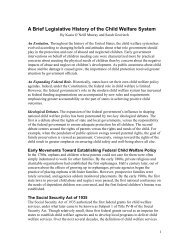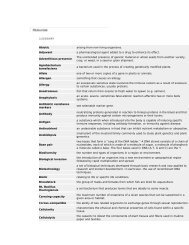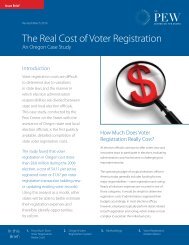After Heparin: - The Pew Charitable Trusts
After Heparin: - The Pew Charitable Trusts
After Heparin: - The Pew Charitable Trusts
Create successful ePaper yourself
Turn your PDF publications into a flip-book with our unique Google optimized e-Paper software.
CHAPTER2<br />
BARRIERS TO FDA OVERSIGHT<br />
2.1 Overview<br />
<strong>The</strong> FDA is responsible for protecting the public health by ensuring the safety and efficacy of human and<br />
veterinary drugs, vaccines and other biological products, medical devices, the U.S. food supply, cosmetics,<br />
dietary supplements and products that emit radiation. 327<br />
<strong>The</strong> precarious state of FDA resourcing and capacity is broadly recognized. <strong>The</strong> regulatory demands<br />
placed on the agency far exceed its ability to respond, according to a 2007 FDA advisory committee<br />
report that outlined serious scientific shortcomings within the agency. 328 Between 1988 and 2007, Congress<br />
passed 123 new laws requiring FDA action, but according to the report, the agency was allocated<br />
only a 9 percent staffing increase through appropriations. 329 <strong>The</strong> FDA’s Principal Deputy Commissioner<br />
from 2009 to 2010, Dr. Joshua Sharfstein, testified at a Congressional hearing in March 2010 that the<br />
agency does not have the resources and authority it needs to ensure the safety of imported drugs and<br />
components, and is not currently able to prevent another tragedy like the heparin adulteration (see case<br />
study 1). 330<br />
<strong>The</strong> FDA has received some important augmentations to its budget in recent years. Total enacted appropriations,<br />
including user fees, were $2.63 billion, $3.25 billion and $3.67 billion for fiscal years 2009,<br />
2010 and 2011, respectively (see figure 13). 331–334 <strong>The</strong> agency also received a supplemental appropriation<br />
of $150 million in June 2008 to support regulatory activities in response to globalization, in particular<br />
food supply safety programs. 335,336 Funding allocations for the FDA’s Center for Drug Evaluation and<br />
Research (CDER) and related field activities in the Office of Regulatory Affairs (the office that conducts<br />
inspections, among other functions) have also increased, although at a slightly lower rate than overall<br />
appropriations. With these funds, FDA has begun to address issues such as understaffing and information<br />
technology (IT) capacity, but as outlined in this chapter, serious capacity and structural problems<br />
remain, and they weaken the agency’s ability to regulate drug manufacturing and importation.<br />
<strong>The</strong> FDA inspects foreign plants that make drugs and ingredients for the United States at much lower<br />
rates than it inspects domestic sites. 337 IT systems for tracking drug manufacturing sites are archaic and<br />
contain data-entry errors. 338,339 An estimated 20 million shipments of FDA-regulated goods entered the<br />
United States in 2010; however, border assessments are hampered by data systems that contain errors<br />
and do not permit effective risk-based targeting (see section 2.3.3). Oversight is also undermined by the<br />
FDA’s lack of enforcement tools and needed authority, such as the power to mandate a recall or to subpoena<br />
documents for investigations.<br />
<strong>After</strong> <strong>Heparin</strong>: PRotecting Consumers from the Risks of Substandard and Counterfeit Drugs 45
















